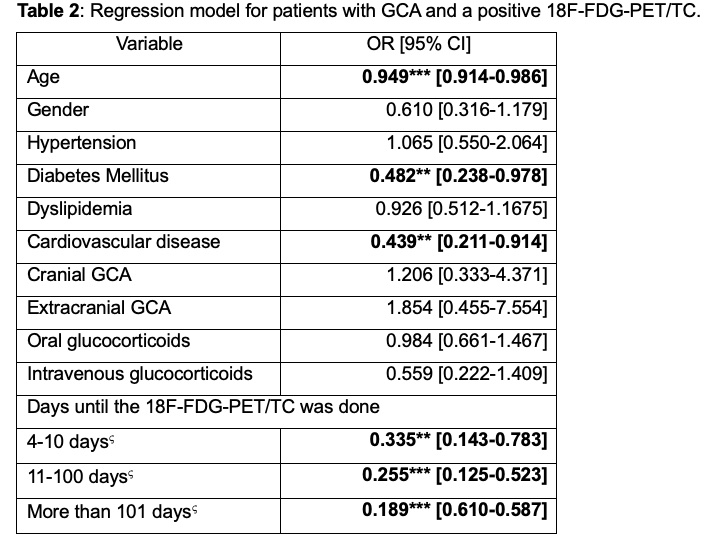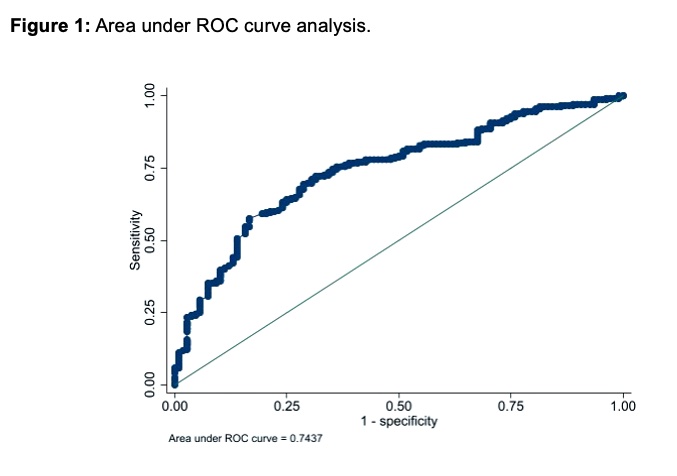Session Information
Date: Tuesday, November 14, 2023
Title: (2387–2424) Vasculitis – Non-ANCA-Associated & Related Disorders Poster III
Session Type: Poster Session C
Session Time: 9:00AM-11:00AM
Background/Purpose: Imaging studies in patients with giant cell arteritis (GCA) and suspected large vessel vasculitis (LVV) are sensitive, increasingly available, and less aggressive than temporal artery biopsy. Positron emission tomography/computed tomography (PET/CT) with 18-fluorodeoxyglucose (18F-FDG) allows for the evaluation of mural inflammation in extracranial arteries and supports the diagnosis of LVV. This study aimed to analyze in which patients with GCA the use of 18F-FDG-PET/CT is useful for detecting LVV.
Methods: ARTESER is a large Spanish registry promoted by the Spanish Society of Rheumatology, including patients with a new diagnosis of GCA, from June 2013 to March 2019. A selection of patients who underwent an 18F-FDG-PET/CT was carried out. The main variable of the study was the presence of vasculitis detected by this imaging technique. The diagnosis of LVV was based on expert opinion. Demographic variables, comorbidities, acute phase reactants, cumulative dose of glucocorticoids prior to the test, and the number of days elapsed before performing the test were considered. The clinical phenotypes were defined as cranial or extracranial, depending on the main symptom at the moment of diagnosis. Results are presented as a bivariable model to analyze differences between patients with positive and negative results, a regression model to approach the association between variables in those with a positive test, and a ROC area under the curve analysis.
Results: From a total of 1675 GCA patients, included in ARTESER registry, 377 met the inclusion criteria of having an 18F-FDG-PET/CT done during the diagnostic process. Table 1 shows the bivariable analysis. 67.4% of patients presented as a cranial-GCA phenotype and 29.1% as extracranial-GCA variant, 18 patients could not be classified as either phenotype. Sixty-five percent of patients in our registry had LVV, as detected by 18F-FDG-PET/CT (n=245). In those patients with a positive PET/TC, the vascular territory most frequently affected was the thoracic aorta (85.7%), followed by supra-aortic vessels (78.8%), and abdominal aorta (57.6%). Cardiovascular risk factors were more frequent in patients with a negative 18F-FDG-PET/CT (Table 1). The regression model (Table 2) shows a negative association with a positive 18F-FDG-PET/CT for older patients, patients with diabetes mellitus and cardiovascular disease and, the odds ratio for having a positive 18F-FDG-PET/TC is lower, as days go by. No variables were found to have a positive association with a positive 18F-FDG-PET/TC. Depending on the cumulative dosage of glucocorticoids, 18F-FDG-PET/CT had an area under the curve of 0.74 (Figure 1).
Conclusion: Younger patients have a higher probability of presenting a LVV detected by 18F-FDG-PET/CT. Patients with cardiovascular risk factors (hypertension, diabetes mellitus, smoking), have a higher probability of a negative 18F-FDG-PET/CT. The most frequent large vessel affected was the thoracic aorta. As days go off, and the cumulative glucocorticoid dose is higher, vascular wall uptake of 18F-FDG is reduced, the reason why 18F-FDG-PET/CT should be performed as soon as possible.
To cite this abstract in AMA style:
Estrada-Alarcón P, Domínguez M, Melero-Gonzalez R, De Miguel E, Silva-Diaz M, Valero J, González I, Sanchez Martin J, Narvaez J, Galindez-Agirregoikoa E, Mendizábal j, Abasolo l, Loricera J, Muñoz A, Castañeda S, Moya P, Moran Alvarez p, Navarro V, Galisteo C, Casafont-Solé I, Roman Ivorra J, SALMAN MONTE T, Rocha M, Iñiguez C, García A, Campos C, Alcalde M, Mas A, Prado F, Blanco R, ARTESER Working Group O. 18f-FDG-PET/CT for Giant Cell Arteritis Detection of Large Vessel Vasculitis: What Should We Take into Consideration? Analytical Study of the Arteser Registry [abstract]. Arthritis Rheumatol. 2023; 75 (suppl 9). https://acrabstracts.org/abstract/18f-fdg-pet-ct-for-giant-cell-arteritis-detection-of-large-vessel-vasculitis-what-should-we-take-into-consideration-analytical-study-of-the-arteser-registry/. Accessed .« Back to ACR Convergence 2023
ACR Meeting Abstracts - https://acrabstracts.org/abstract/18f-fdg-pet-ct-for-giant-cell-arteritis-detection-of-large-vessel-vasculitis-what-should-we-take-into-consideration-analytical-study-of-the-arteser-registry/



